The Dinosaur Coast - Tracking Jurassic Saurians along the Seashore of Northern Spain.
by Diana Fattori
photographs by Nando Musmarra - paleoplates by Loana Riboli
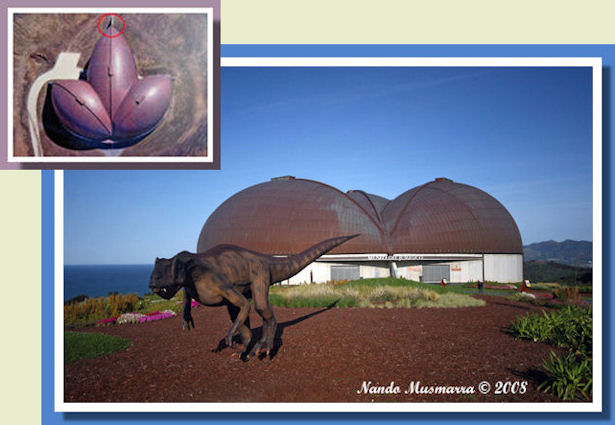
The Jurassic Museum of Asturias building has a theropod footprint shape (see aerial photo).
Travelling across Spain, visitors can easily notice that Asturias is one of the less-crowded regions of the country. Very far from the desert landscape of Andalusia and Estremadura, and from the high-volume dancing music of the never-sleeping coastal cities of Catalunya, there is another side of Spain. Situated in the north of the country, facing Ireland, Asturias has a lot of characteristics more similar to the home of elves and fairies than to the rest of the country.
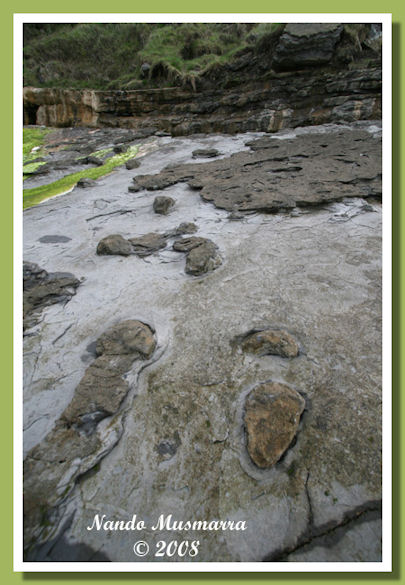
Sauropod tracks at Tereñes beach locality.
In this wave-battered landscape, framed as a green picture, there is one of the more interesting paleontological museums in the whole of Spain: the Jurassic Museum of Asturias, called MUJA. The building itself has a very original structure: the architect Rufino Garcia Uribellarea projected it like a gigantic theropod track dominating the hill. Down the hill, for many miles both west and east, visitors are encouraged to explore Jurassic dinosaurs' trackways—those of theropods, ornithopods, sauropods, and thyreo-phorans, especially Stegosaurs.
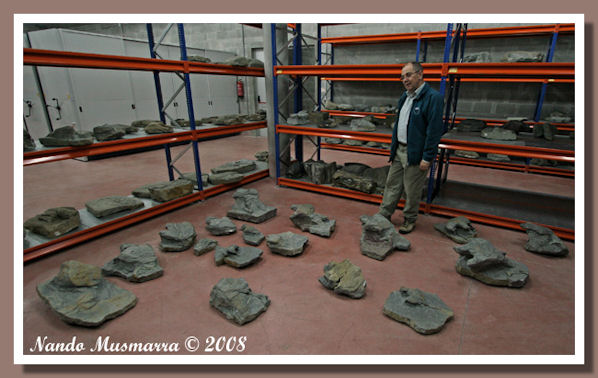
José Carlos Garcia-Ramos in the Museum laboratory.
The museum curator is José Carlos Garcia-Ramos, Professor of Stratigraphy at the Oviedo University in Asturias. When he was a young university student, he used to spend his summer vacations on La Griega beach near Colunga. In 1969, José Carlos noticed for the first time unusual holes on the beach cliffs; those turbations were later proven to be dinosaurs' tracks, actually some of the biggest sauropod tracks in the world. The research was published by José Carlos in 1975.
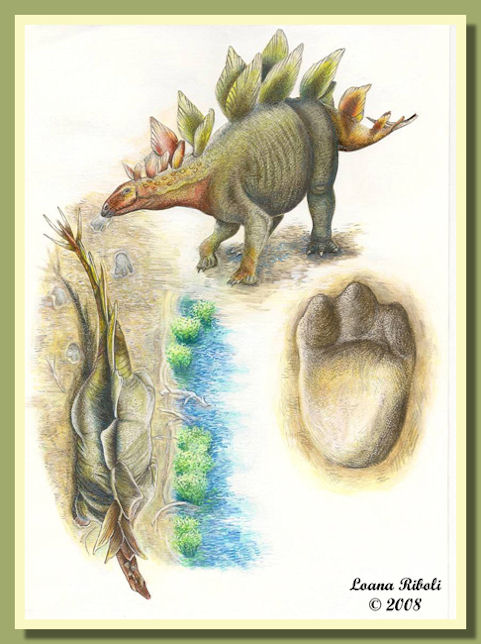
A Stegosaurus leaving footprints on a Jurassic beach - PaleoArt Loana Riboli
Spain is a country with plentiful dinosaur tracks and a popular tradition of creating legends to explain them. It seems that many myths and misconceptions about dinosaurs are based on these footprints. In La Rioja province, for example, dinosaur tracks were interpreted as the tracks of the Apostle Santiago's horse, whose holy relic—found in Compostela—originated the famous pilgrimage trail across Europe.
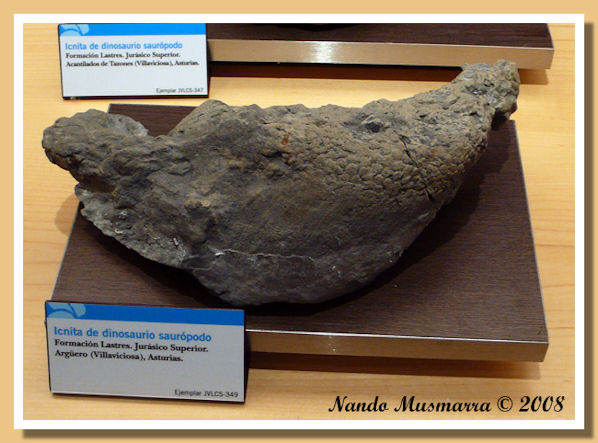
One of the first-discovered sauropod manus (hand) preserving skin impression in the world.
When José Carlos understood that the turbation was caused by dinosaurs, he tried hard to find a local legend invented to explain the mystery; sadly, he found nothing. Seemingly, the huge dinosaur trackways had remained invisible to the local community. For a long time José Carlos and his scientific team investigated the whole Asturian coast. Their research demonstrated that dinosaur tracks span a coastal area between the cities of Gijon and Ribadesella. All the fossil tracks belong to the Upper Jurassic, between 140 and 160 million years old.
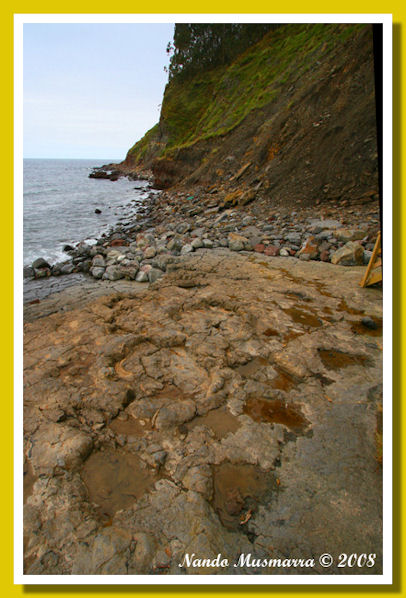
La Griega beach is one of the nine main localities where it is possible to observe dinosaur tracks in situ. Those sauropod tracks are some of the biggest in the world.
This discovery is notable because it was the very first time that dinosaur tracks were found in Asturias. It is very important to notice that Jurassic Asturian beds contain abundant dino tracks, that those tracks were left by several different species of dinosaurs, and that their preservation is very good. Visiting the coastal beds is not a piece of cake. The ichnologists' team had to deal with several difficulties: the Asturian coast is in the northern part of Europe where tides can be really extreme. The range between low and high tide is very high (several meters), so it is possible to walk on the beach for just a few hours without fear of the powerful incoming tide. The Asturias cliffs are very prone to collapse, because they are battered by waves at each high tide and also by frequent rains. Rock falls are relatively common. Seaweed-covered rocks are very slippery, so extra caution should be used. The best time to visit the dinosaur coast is during the three hours before and after low tide.
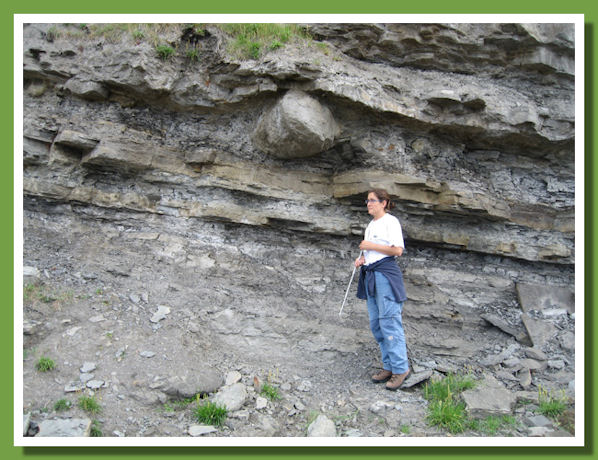
Laura Piñuela exploring the Jurassic beds.
Well, there is always something guarding the treasure... but the Muja team doesn't fear it! This team is composed of three paleontologists: José Carlos Garcia-Ramos, Laura Piñuela, and Ignacio "Ome" Ruiz Omeñaga.
The Muja is a young museum: it was opened on March 31, 2004, and in a short time it has become the most-visited museum of Asturias. There are three main exhibits dedicated to the geologic periods forming the Mesozoic: Triassic, Jurassic, and Cretaceous. Those exhibits direct the visitor's attention to different features related to dinosaurs.
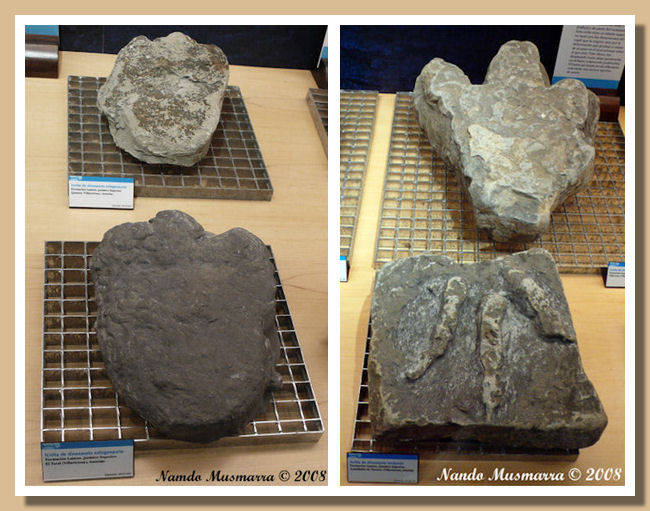
Some dino tracks displayed at Muja. On the left there are rare Stegosaurus tracks.
The Triassic area displays dinosaur fossil remains, not just bones but also footprints, gizzard stones (gastroliths), eggs, and fossil feces (coprolites). Differences between dinosaurs and other non-dinosaurian reptiles are well-explained, focusing on evolutionary novelties. On display there are fossils from the Spanish quarry of Montral-Alcover and a big German Plateosaurus from Trossingen.
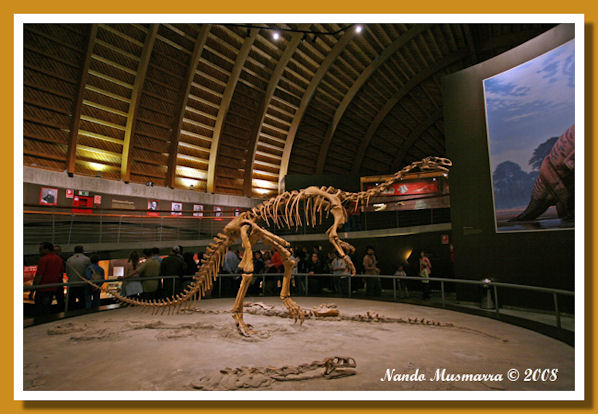
Triassic Plateosaurus from Trossingen, Germany.
The Jurassic area has plenty of information about dinosaurs, explaining the different features of each group: the tremendous weight, the giraffe-like neck and the circulatory system of sauropods; how predatory dinosaurs used their teeth and sharp nails to attack prey and to defend themselves; how the ornithopods ground their food and how thyreophorans used their armor plates above or alongside the vertebral column. In the Jurassic area are exhibited a replica of a big American Camarasaurus and the rich marine fauna from the German quarries of Holzmaden, where complete specimens of Ichthyosaurus (also pregnant females), Plesiosaurus, crocs, fishes and enormous crinoids are preserved.
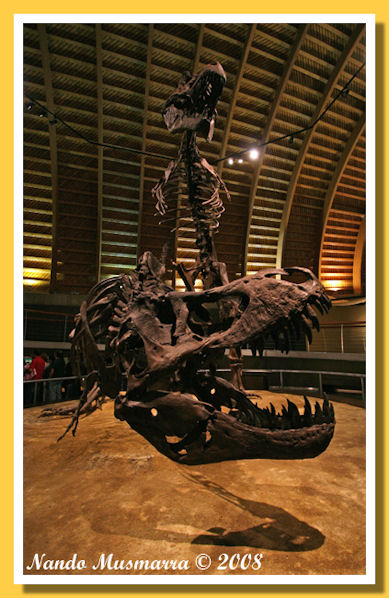
T. rex display from inside the museum.
The last Mesozoic area exhibits Cretaceous fossils and the foremost theories about dinosaurs' behavior are explained, including reproduction and parental care. The most beautiful displays are a couple of T. rex individuals and very rare fossil birds from Las Hoyas quarry in Spain.
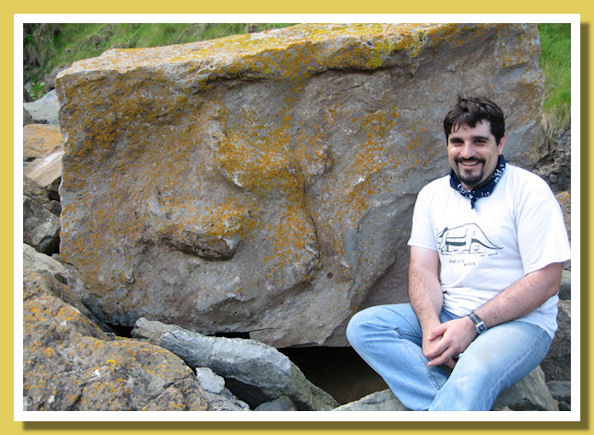
Ignacio "Ome" Ruiz Omeñaga smiling near a big theropod track.
In the Tertiary section there is one of the ancestors of the modern Spanish horses, the Cantabrotherium truyolsi, found in Llamaquique near Oviedo, and in the Quaternary exhibit there are human fossil displays from Atapuerca, Spain, where the older European human fossil was found (Homo antecessor, 1.2 million years old according to dating of the new maxilla found in March 2008).
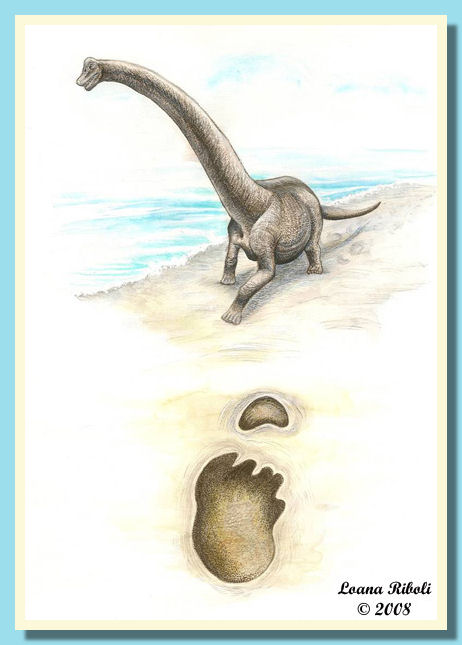
A Brachiosaurus leaving his tracks along the Asturian paleo shore - Loana Riboli
When the museum visit seems come to an end, visitors find themselves in the best part of the building: the Asturian Jurassic area. This period is locally characterized mostly by dinosaur tracks, but the Muja investigation team, while on the beds, has collected a lot of Jurassic fossils: dinosaur bones and teeth, ammonites, belemnites, gastropods, crocodiles, turtles and fishes, saving them from the tides' fury. One specimen that caught my attention was a brachiopod block containing...liquid oil! The brachiopods were buried alive by mud deposited during a Jurassic storm sometime around 190 million years ago. The brachiopods hermetically sealed their valves and the mud covered them completely without filling their interiors. Many years later, when mud consolidated itself under new sediments' pressure, oil contained in the sediments occupied the empty space left in the brachiopods' interior by their soft parts' decomposition. Today, when those brachiopods are broken with a hammer, liquid oil still flows out!
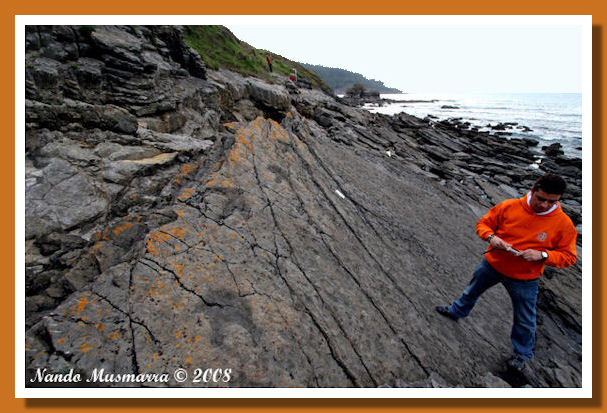
Theropod tracks at Tereñes beach.
In the Asturian Jurassic room there is a big map were the nine main dinosaur tracks localities are posted. Visitors are informed that, once on the spot, there are many signs that help them to reach and identify the tracks.
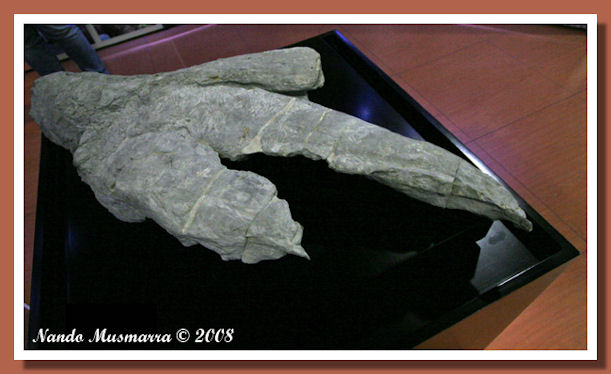
This is one of the biggest theropod track in the world; it measures 82 centimeters from fingertip to heel.
The Muja has one of the bigger European dino track collections housed in a museum. Especially nice are Stegosaurus tracks that, rare elsewhere, are here a common find. Many of those specimens preserve the skin impression. In the Muja is also housed one of the most complete pterosaur track collections in the world and there are also Jurassic tracks made by crocs, turtles, lizards, and many invertebrates, worms, and crustaceans that used to dig burrows in the Jurassic soil.
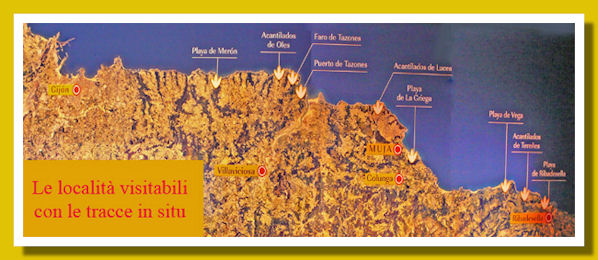
There is also a superb ripple mark collection that preserves records of both marine and fluvial water action on Jurassic sediments. Ripple marks tell us about current direction, depth of the water and, eventually, they are testimonies to the gentle winds that moved the paleo-waters.Asturias has one of the best-preserved Mesozoic seashores in the whole world. For this reason the region, together with five other Spanish communities and Portugal, is waiting to enter in the UNESCO list of Human Patrimony. More info at www.museojurasicoasturias.com and at www.dinoastur.com
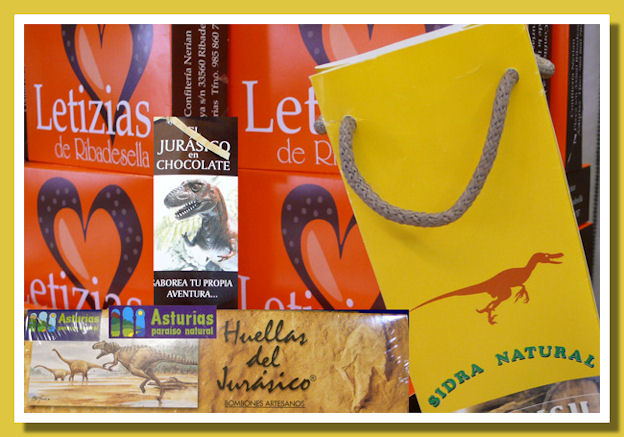
Dinosaurs' food ... to go!
Diana Fattori © 2008
Thanks to Sara Nespral, Beatriz Pandiello and MUJA's team
This article was published on Fossil News Vol. 14 - N.12 - Dic. 2008
